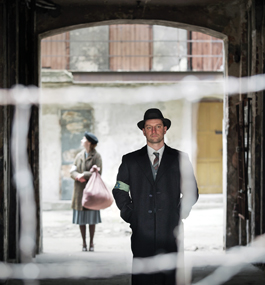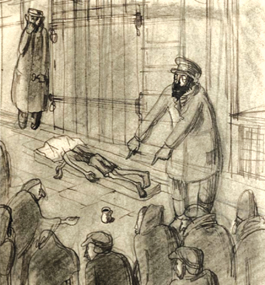‘The Stages of the Dying of a People’
When Jews secretly created and buried a trove of personal accounts detailing their daily existence in the Warsaw Ghetto, they gave their stories lasting life.

Anna Wloch
RESISTANCE: Actor Wojciech Zielinski played Oyneg Shabes member Abraham Lewin in reenactment scenes in the documentary “Who Will Write Our History.”
by Joseph Dorman
“Voices From the Warsaw Ghetto,” edited by David Roskies ’69, MA’71, PhD’75, is a book of unrelenting power. You read it the way you might burn through a fever: dizzied by its force, aware that you have no choice but to surrender to its grip.
The book is compiled from a singular source, the Oyneg Shabes archive, created inside the Warsaw Ghetto, the largest ghetto in Nazi-occupied Europe. The archive project was the brainchild of its director, Emanuel Ringelblum, a historian in charge of the Aleynhilf (Self-Help), a social-welfare group that operated inside the ghetto. Oyneg Shabes means “Joy of the Sabbath”; the first meeting of its members took place on a Friday night.
Ringelblum’s idea was to enlist his fellow Jews in secretly recording their own history as it happened, moment by moment. He called on professional writers, journalists and ordinary citizens — anyone willing to lend a hand. The project began in May 1940, less than a year after the Nazi occupation of Poland. It carried on through the sealing off of the ghetto in November 1940, and ended only after the ghetto’s final uprising and fiery destruction in April and May 1943.
Oyneg Shabes members tended to be socially committed individuals. Beyond that, it was a varied group: “the young and the old, men and women, Marxists and Zionists, believers and skeptics,” as historian Samuel Kassow notes in his preface. Ringelblum encouraged his volunteers to document everything — the emotional details of their personal lives, the ghetto’s social and economic activity, its dark humor. Even the changing faces of the ghetto’s men, women and children were recorded in watercolor, charcoal and pencil by artist Gela Seksztajn.
Ultimately, three caches of Oyneg Shabes documents were buried in separate hiding places. Two were discovered after the war, revealing 1,693 items comprising 35,000 pages. The third cache, still missing, may lie under what is now the Chinese embassy in Warsaw.
Roskies, a professor of Jewish literature at the Jewish Theological Seminary, and a preeminent scholar of Yiddish literature and culture, first discovered Ringelblum’s story in the 1960s, when he was 16. Browsing a Yiddish bookshop in his native Montreal, Roskies found an English translation of Ringelblum’s “Notes From the Warsaw Ghetto.” The book transfixed Roskies, who went on to develop a deep personal and professional interest in the Holocaust and its literature. As a student at Brandeis, he initiated the first Holocaust commemoration on any U.S. college campus. Since then, he has written a number of important books on the Holocaust, one of which included selections from the Oyneg Shabes archive.
But it was only after being interviewed by director Roberta Grossman for her acclaimed 2018 documentary on Oyneg Shabes, “Who Will Write Our History” (based on the book of the same name by Kassow), that Roskies realized he had to create “Voices From the Warsaw Ghetto,” which tells the story of the ghetto chronologically, through the archive’s documents.
Though he necessarily includes only a small portion of the voluminous archive, Roskies does a masterful job of editing the material so that readers feel they are living the tragic history in real time. One after another, the various pieces reproduce the texture of life in the ghetto, spinning the threads of its inhabitants’ experiences into a fabric of courage and desperation.
Oyneg Shabes members understood they were working under the pressure of time. The ghetto’s boundaries and its population were in constant, ominous flux. Inhabitants fled, hoping to find freedom in Soviet-controlled territories, while refugees poured in from evacuated towns. Starvation and death were everywhere. Then the transports to the camps began.
“The war changed Jewish life in the Polish cities very quickly,” Ringelblum wrote. “No day was like the preceding. Images succeeded one another with cinematic speed.”
Roskies’ volume begins with the Jews’ first taste of isolation under the German occupation. In a poem titled “Telephone,” Wladyslaw Szlengel describes manning his apartment building’s single working phone: “With my heart broken, and sick / […] I think: let me ring / someone on the other side / […] And suddenly I realize: my God there / is actually no one to call, / […] Our ways have parted.”
Soon, extreme hunger began to strip the ghetto’s inhabitants of a sense of their own humanity. As Leyb Goldin writes of his alter ego, the young intellectual Arke, in “Chronicle of a Single Day,” the volume’s most brilliant piece, “It’s you and your stomach. It’s your stomach and you. It’s 90 percent your stomach and a little bit you.” Arke’s world revolves around the small portion of soup he is allotted each afternoon. Unable to concentrate, he cannot turn to his books for diversion. Besides, the minute social observations made by the great novelists seem meaningless in a world where society is falling apart. Arke comes to view his mind as a useless machine churning out thoughts — “sick fantasies,” his stomach tells him — in the service of appeasing his unappeasable hunger.
Oyneg Shabes’ mission was not simply to record suffering. Ringelblum’s aim was an objective account of life in the ghetto, capturing the ugliness and the conflicts in addition to the decency and the self-sacrifice.

DEATH: A drawing, likely done in 1941 and signed “Rozenfeld,” from the archive.
page 2 of 2
In “House No. 21,” Peretz Opoczynski, a shoemaker and Yiddish journalist, records with cold precision the lives of his building’s inhabitants. The young newlywed shot dead when she tries to flee across the Lithuanian border. The endless squabbles over rent between a landlady and her poor tenants. The woman who scoffs at a father’s heartbreak and death after his daughter marries a thief. (Why? The father is a Hasid. “Only a Hasidic daughter could fall for a crook,” the woman says dismissively.)
Her hatred is balanced, and perhaps answered, by the spiritual force of another piece, “Holy Fire.” Its author, the Hasidic rabbi Kalonymus Shapira, rejects the cynicism the ghetto’s desperation could breed. Shapira refuses to believe God has abandoned the Jews. In fact, God is weeping with the children of Israel but must hide himself because the boundlessness of his divine sorrow cannot be contained by the world, Shapira writes: “He, may He be blessed, secludes Himself in His inner chambers — the Jewish person communes with Him there, each individual in accord with his situation.”
The unflinching gaze of the Oyneg Shabes writers did not spare the Judenrat, the Nazi-appointed Jewish council that oversaw the ghetto’s residents and was ultimately forced to collaborate in their deaths. The power and protected status of its members, drawn from the wealthy elite of Jewish Warsaw, made them obvious targets of resentment and anger. Chaim Kaplan, in the piece titled “Scroll of Agony,” describes the Judenrat rule as an awful parody of the return of the Jewish Kingdom and excoriates its members as self-hating social climbers who take advantage of the poor.
Yehoshue Perle was one of the fortunate ones who obtained a precious identification card that entitled him to a job, sparing him from deportation until the end came. The card number assigned to him, 4580, is the title of his sardonic archive entry. “Lucky me, I’m a number,” he writes in homage to Sholom Aleichem’s great character, Motl, the cantor’s son. (“Lucky me, I’m an orphan!” the young Motl declares, happy to be free of his father’s authority.) Perle’s “luck” leaves him shorn of his reputation and his good name. His entire being and worth have been reduced to four digits doled out by the Judenrat.
Roskies notes that Oyneg Shabes members were stunned into silence only once — in September 1942, during what became known as the Cauldron, the five most horrific days of the Great Deportation, which sent 300,000 Jews to their deaths, including many Oyneg Shabes members. But they soon resumed and ceaselessly worked until the final destruction of the ghetto in April and May 1943. By then, Warsaw’s Jews had risen up against their Nazi persecutors. “The cattle awoke / And / Bared their teeth,” Szlengel writes in one of the book’s final pieces, the poem “Counterattack.” Meanwhile, Oyneg Shabes members buried the final cache of their archive.
“Who can render the stages of the dying of a people?” writes Rachel Auerbach in “Yizkor, 1943,” the last piece Roskies includes, completed shortly after the ghetto’s final dissolution and several years before the archive documents were recovered after the war. When she wrote these words, Auerbach, one of only two members of Oyneg Shabes to survive, who would dedicate her life to collecting Holocaust witness testimony, was unaware she and her fellow archivists had managed to accomplish this very feat.
“What we were unable to cry and shriek out to the world we buried in the ground,” wrote 17-year-old David Graber. Thanks to Ringelblum’s foresight; the utterly remarkable determination of the Oyneg Shabes writers; and the work of Roskies, Kassow, Grossman and others, we hear those shrieks today.
Joseph Dorman is a filmmaker and writer living in New York City.
